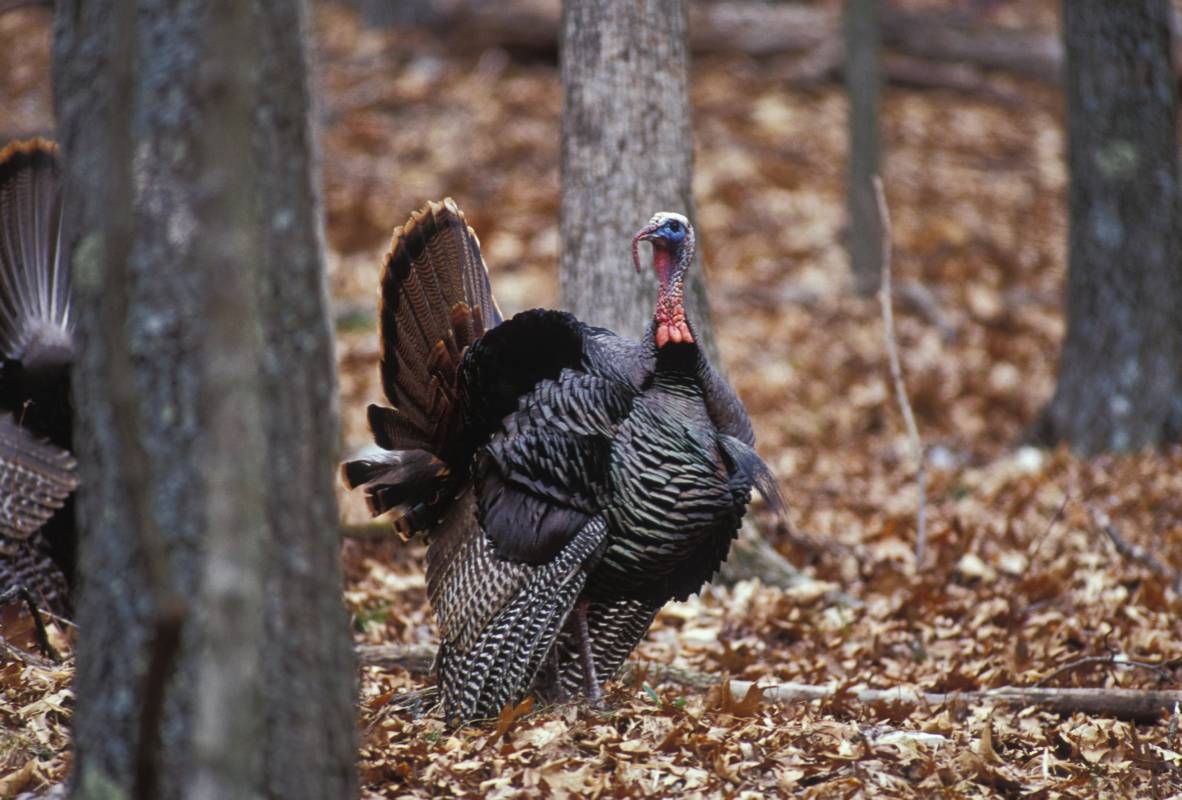Get tips on providing cover, food, and water for your wild turkey.
A popular game bird, the wild turkey can be found in mixed forests and grasslands statewide. Turkeys are opportunistic foragers with a diverse appetite and an assortment of cover needs between seasons, giving property owners plenty of opportunity to enhance wildlife potential in their area.

Turkeys prefer open, mature woods near pastures, hayfields, old fields, and cropland. Stands of smaller trees may also be used if the understory is not too dense.
Title
Nesting Habitat
One thing that all turkey nesting sites have in common is dense vegetation within 2–4 feet off the ground. Incubation takes 28 days, so it is important for the hen to choose a nest location with good concealment. Potential nest sites include:
- Forest openings
- Power line rights-of-way
- Old fields
- Native grass stands
Turkeys may choose their nesting site based on proximity to good brood habitat or the time of year. Early season nests are often associated with wooded sites, but as spring progresses and herbaceous cover grows, late nesting or re-nesting hens may choose nest sites in fields.
Title
Brood Habitat
Brood sites will consist of early successional habitats such as weed patches and fallow fields with a diverse mix of annual plants. These environments attract insects and other invertebrates that poults will feed on intensively during the first few weeks of development.
The best brood sites are found near tree cover, to allow escape from predators. Well-managed savannas with mast-producing trees like oak make excellent brood habitat. These sites must provide cover that is tall enough to conceal foraging poults but short enough for the hen to have good visibility to detect predators.
Enhance brood habitat on your property with the following practices:
- Idling a few acres of crop ground near woods
- Thinning and/or burning wooded areas to promote ground cover
- Using prescribed fire to stimulate new vegetation in old fields and native grass stands
Title
Seasonal Habitat Needs
Summer and fall habitats may consist of mowed hay fields, grazed pastures, glades, or open woods. These are important habitat spots for hens and their poults, as the low plant cover in these areas often provide an abundance of insects and seeds.
Expect to see increased use of forest cover from turkeys between October and March. Mature, hardwood forest is ideal for turkeys during winter, the best areas being comprised of 50 percent mature, mast-producing hardwoods.
Turkeys are opportunistic foragers with a diverse appetite. They prefer acorns when they are available but will also eat the seeds, buds, leaves, and tubers of many other plants. Their principal natural plant foods fit into the following general categories:
- Mast (acorns)
- Fruits (dogwood, grapes, cherry, and hackberry)
- Seeds (weeds, grasses, and some sedges)
- Greens (grasses, grass-like plants, and selected annual and perennial broad-leaved plants)
Title
Winter Reserves
Turkeys will make use of cultivated plots, especially during periods of persistent snow cover or shortened food supplies. A few rows of corn or soybeans left standing next to timber will ensure a convenient food source for deer and turkey alike.
Title
Food for poults
Insects and other invertebrates are necessary to meet the poult’s acute nutritional demands. In fact, close to 90 percent of a poult’s waking life is spent feeding within the first month.
Fields and forest openings tend to have a higher concentration of insects than wooded areas, making them superior brood-rearing habitats. Take this into consideration when planning for developments. In plots with extensive forest coverage, at least 10 percent of the area should be in scattered openings.
Title
Water
Although wild turkeys acquire some water through the foods they eat, the availability of surface water will greatly improve habitat for the species. One pond, stream, or other water source per quarter section of land is usually adequate. Check out Better Turkey Habitat for specifics on constructing a suitable water source for turkey on your land.
- Acorns
- Blackberries
- Bluegrass
- Cherries
- Chufa
- Clovers
- Crabgrass
- Crotons (such as hogwort)
- Crop residues of corn, milo, and soybeans
- Dandelion
- Dogwoods
- Domestic crops
- buckwheat
- corn
- cowpeas
- millet
- oats
- sorghum grain
- soybeans
- Grapes
- Grass leaves
- Hackberry
- Hawthorns
- Hickory nuts
- Insects
- Korean lespedeza
- Paspalums (such as pitchfork grass)
- Poison ivy
- Ragweeds
- Roses
- Sedges
- Smartweeds
- Sorrels
- Strawberry
- Sumacs
- Sunflowers
- Tick trefoils
- Wheats
- Wild beans





















